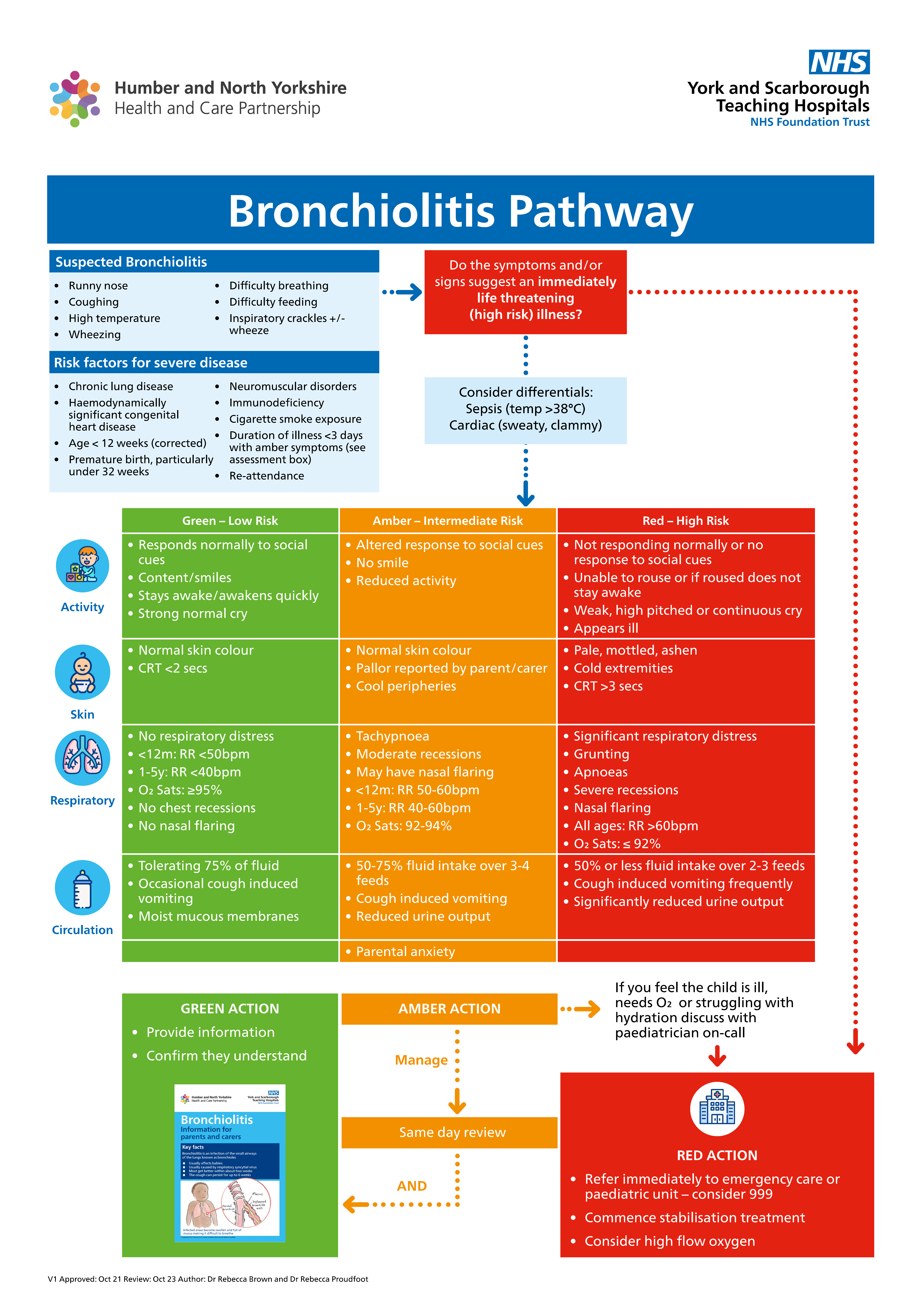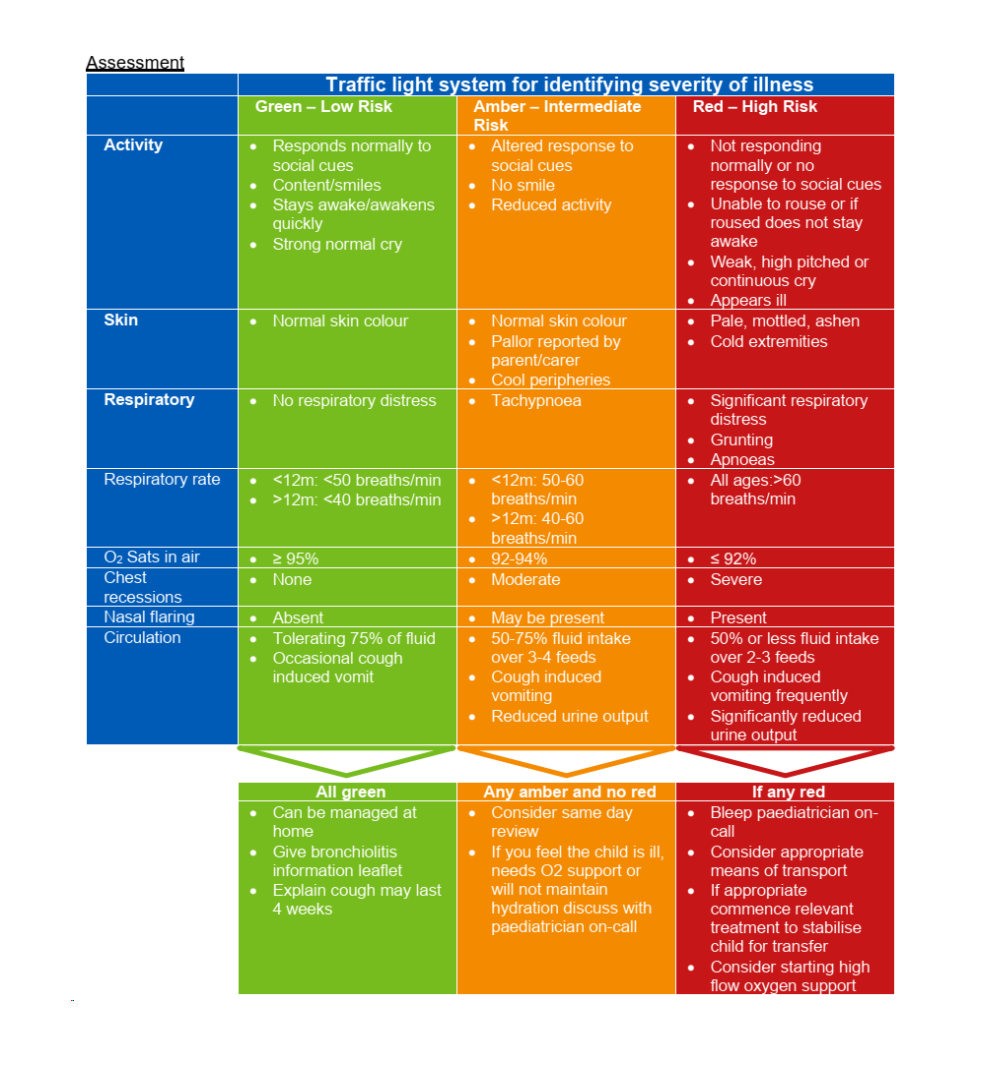Bronchiolitis in children
Definition/Description
A lower respiratory infection affecting babies and children under two years. It is characterised by epithelial cell destruction, cellular oedema, and airway obstruction by inflammatory debris and mucus.
It usually presents with 1-3 day history of coryzal symptoms followed by the appearance of cough, fever and progression to respiratory distress. Peak of illness is typically 3-5 days.
Paediatric Normal Values (adapted from APLS) |
|||
Age |
Resp Rate |
Heart Rate |
Systolic BP |
Neonate <4w |
40-6 |
120-160 |
>60 |
Infant <1 y |
30-40 |
110-160 |
70-90 |
Toddler 1-2 yrs |
25-35 |
100-150 |
75-95 |
2-5 yrs |
25-30 |
95-140 |
85-100 |
Red Flag Symptoms
- Worsening work of breathing (e.g., grunting, nasal flaring, marked chest recession).
- Fluid intake is less than 50-75% of normal or no wet nappy for 12 hours.
- Apnoea or cyanosis.
- Exhaustion (e.g., not responding normally to social cues, wakes only with prolonged simulation).
Low Threshold for Admission
- Chronic lung disease
- Haemodynamically significant congenital heart disease
- Age < 12 weeks (corrected)
- Premature birth, particularly under 32 weeks
- Neuromuscular disorders
- Immunodeficiency
- Cigarette smoke exposure
- Duration of illness
Guidelines on Management
- Most common reason for admission in first year of life.
- In the UK, the peak incidence is reported between November and March.
- Respiratory syncytial virus (RSV) accounts for the majority of cases.
- Rhinovirus, human metapneumovirus, influenza, parainfluenza and adenovirus can all cause bronchiolitis.
- Most children recover without sequelae, however, up to 40% may have subsequent wheezing episodes up to age five and 10% after age five.
Presenting Features
Bronchiolitis is a clinical diagnosis based entirely on history and clinical examination with a classic triad of diffuse inspiratory crepitations, expiratory wheeze and hyperinflation.
History |
Examination |
|
|
* Young infants aged under 6 weeks can present with apnoeas without other clinical signs
Differential Diagnoses
- Other pulmonary infections, e.g. pneumonia
- Laryngotracheomalacia
- Foreign body aspiration
- Gastroesophageal reflux
- Vascular ring
- Allergic reaction
- Cystic fibrosis
- Mediastinal mass
- Tracheoesophageal fistula
Features that may indicate diagnoses other than bronchiolitis
- The classic triad of diffuse inspiratory crepitations, expiratory wheeze and hyperinflation are key to the clinical diagnosis.
- All other features mentioned above could be seen in many other pathologies.
- Absence of one of the classic triad may prompt further consideration of other differentials
Measuring O2 Saturations
- A saturation probe needs to cover a child’s finger or toe with a good seal.
- If there is a large gap it will underestimate the child’s saturations.
- An adult probe on the big toe of a child could be used in a child 5 years or over.
- Use a paediatric probe in children under 2 years.
Treatments NOT recommended for bronchiolitis:
- Antibiotics
- Inhaled beta-2 agonist bronchodilators (although worth trying if atopic background)
- Oral systemic corticosteroids
- Inhaled corticosteroids
Referral Criteria/Information
When to Arrange Emergency Hospital Admission
- Apnoea (observed or reported).
- Persistent O2 saturations in air of ≤ 92%.
- Inadequate oral fluid intake (less than 50-75% of usual volume).
- Persisting severe respiratory distress, e.g. grunting, marked chest recession or a respiratory rate > 60 breaths/minute.
When to Consider Hospital Admission
- A high respiratory rate;
- <12m: 50-60 breaths/min
- >12m: 40-60 breaths/min
- Difficulty with breastfeeding or inadequate oral fluid intake (50-75% or less of usual
- volume).
- Clinical dehydration.
- Persistent O2 saturations of 92-94% when breathing air.
Additional Resources & Reference
Patient information leaflets/ PDAs
Patient info/chest-lungs/bronchiolitis-leaflet
Patient-info/health-advice/paediatric-bronchiolitis-advice-sheet
Traffic light system for identifying severity of illness
References
- BMJ Best Practice (2021) Bronchiolitis [Viewed 15 Aug 2021]
- National Institute for Clinical Excellent [NICE] (2021) Bronchiolitis in children: diagnosis and management NICE guidelines [NG9] [Viewed 15 Aug 2021]
- National Institute for Clinical Excellent [NICE] (2021) Management of bronchiolitis. [Viewed 15 Aug 2021]
Associated Policies
Specialties
Places covered by
- vale-of-york
Hospital Trusts
- york-and-scarborough-teaching-hospitals

